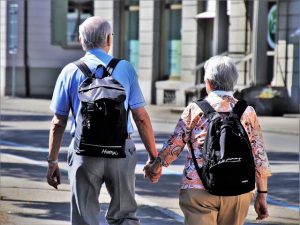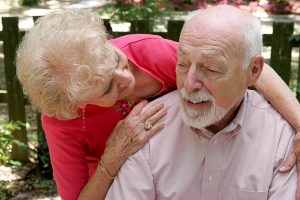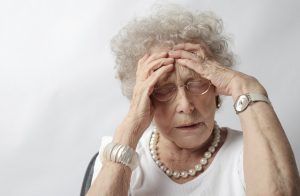The 6-Step Process of Stroke Recovery
According to the CDC, nearly 800,000 persons in the United States have a stroke each year. This is about one every 4 minutes, resulting in over 130,000 deaths annually. Stroke is simply defined as an interruption to the blood supply to the brain and is caused by a clot or hemorrhage. It can be a devastating problem for survivors, resulting in changes in mobility, cognition, speech, swallowing, bowel and bladder, self-care, and general functioning to varying degrees. Some people recover completely after a stroke, but others experience lifelong challenges.
The good news is that there is hope and quality of life after stroke. In my research with stroke survivors, I discovered 6 phases that survivors reported as they made the journey through rehabilitation towards recovery. These steps can be used to see where a person is in the recovery process, help us understand how they may be feeling, and help guide the way we interact with them.
Agonizing: In this first phase of the process, stroke survivors are in shock over what has happened to them. They can’t believe it, and may even deny the warning signs of stroke. The important task during this time is survival from the stroke itself. Call 911 if you see the warning signs of facial droop, arm weakness, or speech difficulties.
Fantasizing: In the second phase of the stroke process, the survivor may believe that the symptoms will all go away. Life will return to normal, and there is a sense of the problem being unreal. Time takes on a different meaning. The way to help is to gently help them recognize reality, and without taking away hope for recovery.
Realizing: This is the most important phase that signals a turn in the recovery process. This is when the survivor realizes that he/she may not fully recover from the effects of the stroke and that there is work to be done to rehabilitate and reclaim life. Common feelings during this phase of realizing are anger and depression. The way to help is to encourage the person to actively engage in rehabilitation. The real work of recovery is just beginning.
Blending: These last 3 phases in the process of stroke recovery may be occurring at much the same time. This is where the real work of adaptation to life after stroke begins. The survivor begins to blend his “old life” before stroke with his new life as a stroke survivor. He/she may start to engage in former activities even if it requires adaptations to be made. He/she will be actively engaged in therapy and finding new ways to do things. The way to help is to promote education. This is a time when survivors are most ready to learn how to adjust to life after stroke. Listen to your rehab nurses, therapists, and physician. Be active in the recovery process.
Framing: During this phase, the individual wants to know what caused the stroke. Whereas in the Agonizing phase they were asking “why me?”, now they need to the answer to “what was the cause?” Stroke can be a recurring disorder, so to stop a subsequent stroke, it is important to know the cause. Interestingly, if the physician has not given the survivor a cause for the first stroke, patients often make up a cause that may not be accurate. Help the survivor to learn from the health care provider what the cause of his/her own stroke was. Then steps can be taken to control those risk factors.
Owning: In this final phase of stroke recovery, the survivor has achieved positive adaptation to the stroke event and aftermath. The survivor has accomplished the needed grief work over the losses resulting from the stroke. He/she has realized that the effects may not go away and has made positive adjustments to his/her life in order to go on. Survivors in this phase have blended their old life with the new life after stroke and feel better about their quality of life. While they still may revisit the emotions of the prior phases at times, they have accepted life as a survivor of stroke and made good adjustments to any changes that resulted. They feel that they have a more positive outlook on life. At this point, survivors can use their experience to help others cope with life after stroke.
For more information about stroke recovery, visit www.seniorcarecentral.net and view Dr. Mauk’s model for stroke recovery.
Guest Blog: Tips on Caring for Loved Ones with Dementia
Dementia is a chronic or progressive syndrome that affects a person’s thinking, memory, comprehension, orientation, language, learning capacity, judgment, and calculation. People with dementia slowly lose their cognitive abilities, which leads to a decline in their social behavior and emotional control. Dementia develops when the brain is injured or damaged, such as what happens to individuals with Alzheimer’s disease.
According to the Alzheimer’s Association, over five million Americans are currently dealing with Alzheimer’s dementia. An estimated 80% are seniors aged 75 and up. If proper care, attention, and medication are not prioritized, the total can balloon to 13 million by 2050. Medical and health facilities are doing every means possible to address the situation.
If your senior family member has dementia and living at home or is under assisted living care, your best contribution is to care for your loved one properly. Here are tips to help you out.
Ask simple questions.
Someone with dementia will find open-ended questions confusing and intimidating. Instead of asking “what” questions, try to rephrase them to “yes-no” questions. For example, instead of asking, “What time would you like to take a bath today?” try asking, “Would you like to take a bath at 4 pm?”
Keep your words simple and clear.
Allow your loved one to help with daily tasks.
When dementia progresses, your loved one may find it difficult to remember and focus on tasks. You can help him or her maintain daily activities and skills and stay active. Allow him or her to assist you with simple activities such as setting the table, making the bed, and gardening. Help your loved one remember tasks and things by placing memory aids, such as signs and labels, all over the house.
Take your loved one to lunch.
Keeping senior loved ones with dementia socially active is essential. Have lunch together at his or her favorite restaurant. Go to a place where he or she used to frequent when communication wasn’t yet a problem. Make your loved one feel special and important.
Hold and touch your loved one.
Your touch is very powerful and reassuring. Hold your loved one’s hand or stroke his or her face now and then. Let him or her feel your love and support.
Most important of all, ask for help. Talk to a caregiver or get in touch with an assisted living care facility.
About the Author
Melissa Andrews is the Content Marketing Strategist for Paradise Living Centers, an assisted living center for seniors with locations in Paradise Valley and Phoenix, Arizona. In her spare time, she enjoys cooking and going on hiking trips with her siblings and cousins.
Guest Blog: How Technology is Changing Elderly Care
 Applying new technologies to in home senior care has significantly contributed to the quality of life by enhancing their daily living needs such as transportation, communication, health, and social participation. Telemedicine, voice command technologies, blood pressure cuffs, remote glucose monitors are some of the few technologies that have impacted elderly care. This article discusses various ways in which technology is changing elderly care.
Applying new technologies to in home senior care has significantly contributed to the quality of life by enhancing their daily living needs such as transportation, communication, health, and social participation. Telemedicine, voice command technologies, blood pressure cuffs, remote glucose monitors are some of the few technologies that have impacted elderly care. This article discusses various ways in which technology is changing elderly care.
Technologies are filling the caregiver gap
There is a massive growth of the elderly population which has increased the demand for caregivers. According to research by AARP, there will be about 50 million caregivers in the US by 2020, 45 million of them being unpaid family members. At the same time, there will be 120 million people in need of a caregiver. Many companies have therefore used their knowledge to create technologies that have smoothen caregiver’s work. These technologies have been designed to solve or ease various elderly needs, such as keeping track of their daily activities, medication, exercise programs, and monitoring meals.
Devices prevent wandering
Seniors with dementia and Alzheimer’s disease always need to escape a situation because they are confused or disoriented. These diseases common in the elderly erase their memory-making familiar places to be unfamiliar. These cognitive impairments make the elderly lose direction and could apt walk to dangerous places. In an aged care facility, to be precise, the seniors wander because of inactivity or boredom. Wandering gives caregivers and relatives an alarm for fear that the senior will get hurt or get lost. To address this problem, several devices have been developed, and they include bed and door alarms.
Some pendants provide GPS for the elderly, especially those under medication and prone to getting lost. Some of these apps with GPS location include angel sense, GPS Smart sole, MedicAlert safely home, and others are still under development by HCI (Human-Computer Interaction) experts.
Cameras that protect the elderly from abuse
Due to other duties you need to attend to, it is impossible to stay around nursing the aged. Small cameras are one of the most significant ways to ensure that the older person is adequately cared for. You will have to place cameras in indiscreet locations. This camera will take footage of daily activities, and thus you will be able to know that the caregiver you hired or some family members are not mistreating your elderly loved ones.
Remote technology offers 24/7 protection
Caregiving from a distance has always had innumerable challenges. Senior safety tech industries have made life easy for caregivers by developing caregiver alert systems and elderly monitoring systems. There are different options to ensure that the elderly is safe and in good health while you are away. Monitoring devices used include:
- Sensors that turn off stoves if they are left for too long.
- Sensors to inform you if the elderly left the water running.
- Locked medication dispensers equipped with alarms and timers for missed doses.
- Voice-activated virtual assistants.
- Intelligent sensors that learn the elderly routine.
Smartphones to promote self-care
Smartphones are handy for seniors. It helps them stay connected with their grandchildren by video chatting, controlling other intelligent devices, monitoring health through pastern, and lots of features that improve the quality of life for the elderly.
Other benefits of smartphones to the seniors include:
- Making emergency calls.
- Using GPS to navigate when driving or walking.
- Accessing the internet.
- Looking at date and time.
The top features of a senior smartphone include:
- Simple menus.
- Larger buttons and screens.
- Emergency button.
- Fitness and health tracking tools.
Smartphones can serve the purpose of entertainment to seniors. Seniors can now break boredom through games, audiobooks, podcasts, and social media. This is mainly for those who are living alone. They also come pre-installed with a virtual assistant that responds to voice commands and questions.
In addition to the above technologies, the best way to avoid the elderly being mistreated is to hire a caregiver whose background check has been thoroughly conducted. Some online platforms specialize in this area, for instance, Caregiver, engaging in home-care services for the seniors. They provide the simplest and most effective way to find the right caregiver for your loved ones. In short, Caregiver empowers you to find the best in-home senior care.
Conclusion
Technology advancements have influenced how family caregivers and health care providers approach eldercare. It has bridged the caregiver gap and allowed seniors to age gracefully. These technologies have provided a mechanism for caregivers to assess the health of the elderly and provide appropriate medication.
Essential Tools for Seniors with Parkinson’s
If you or someone you care for has Parkinson’s disease, you may encounter a wide array of symptoms on a day to day basis from tremors to muscle rigidity to slowed movements, balance problems, and speech changes. Non-physical symptoms can accompany the disease as well including trouble sleeping, mood changes, urinary urgency, constipation, even loss of smell.
When it comes to managing this type of chronic autoimmune condition, in addition to a comprehensive treatment planned laid out by your doctor, assistive equipment can go a long way in simplifying daily life:
Adaptive Utensils
Advancements in science and technology have made their way into the kitchen market providing relief to people who may otherwise have difficulty feeding themselves. Adaptive utensils are specially designed to help counteract tremors someone with Parkinson’s may have in their hand when holding a fork or spoon, for example.
Other helpful dining aids may include weighted cups and bowls (that are less likely to tip over), and plate guards or high-rimmed plates that prevent food from falling out.
Bedroom Equipment
People with Parkinson’s are at increased risk of falling so supportive equipment around the bed can definitely make this fall-prone environment safer. Install bed rails to aid seniors with limited mobility or try a super pole that stands fixed beside the bed or a pull strap that connects to the end of the bed and makes it easier to sit up.
Bedside commodes can also simplify the task of night time toileting, especially for Parkinson’s sufferers with incontinence issues.
Dressing Aids
As dexterity and finger nimbleness falls prey to the contracture of muscles and joints in the hands, getting dressed on your own can become difficult. This key marker of independence may be retained in some respects with dressing aids that allows a person with Parkinson’s to dress themselves. Tools like button hooks, zipper pulls, one-handed belts, dressing sticks, and shoe horns can all go a long way to promoting self-reliance even as the disease progresses.
Bathing Tools
Maintaining personal hygiene has the ability to improve your sense of confidence and your mood, no matter what Parkinson’s brings your way. Equipment that makes bathing safer and reduces the risk of falling includes shower transfer chairs, grab bars (inside and outside the shower), and non-slip bath mats. Additional bathroom tools may include weighted holders for toothbrushes, razors, etc. as well as removable shower heads and long-handled bath sponges and scrubbers.
The Role of the Rehabilitation Nurse
You may have heard of rehabilitation nursing, but are you familiar with what rehabilitation nurses do and their essential role in health care? According to the Association of Rehabilitation Nurses (ARN), there are four major domains within the new competency model for professional rehabilitation nursing (ARN, 2016) that can help us understand what rehabilitation nurses do. In this blog, we will look at the ARN model from a layperson’s viewpoint to help explain the role of the rehabilitation nurse. Rehabilitation nurses:
Promote successful living
Rehabilitation nurses do not only care for people, but they promote health and prevent disability. This means that rehab nurses engage in activities that help patients, families and communities stay healthy. Proactively, you might see rehab nurses helping with bike safety (such as promoting the wearing of helmets), car seat fairs (to keep children safe from injury), or stroke prevention through community screenings and teaching about managing risk factors. As rehab nurses, we also help patients towards self-management of existing chronic illness or disability, teaching them how to be co-managers with their health providers so they can maintain independence and have a good quality of life. Another key activity is facilitating safe care transitions. This means that rehabilitation nurses have a special skill set to know which setting of care is best for the patient to move to next and how to make this happen smoothly. For example, if Mrs. Smith has had a stroke and finished her time in acute rehabilitation in the hospital, but she lives alone and is not quite ready to go home, what is the best care setting or services for her to receive the help she needs? Many errors, such as those with medications, happen when patients go from one place to another in the health system. Rehabilitation nurses can help persons successfully navigate these complexities and be sure that clients get the continuity of care they need and deserve.
Give quality care
The interventions or care that rehabilitation nurses provide to patients and families is based on the best scientific evidence available. Part of being a rehab nurse is staying current on the latest technology, strategies for care, and best practices. This is to ensure that all patients receive the highest standard of care possible. We stay current in many ways, including reading journal articles, attending conferences, obtaining continuing education, and maintaining certification in rehabilitation. Research shows that having more certified rehabilitation nurses on a unit decreases length of stay in the hospital. In addition, all of rehab care focuses on the patient and family as the center of the interdisciplinary team. To this end, rehabilitation nurses teach patients and families about their chronic illness or disability across many different areas including: how to take medications; managing bowel and bladder issues; preventing skin breakdown; dealing with behavioral issues that might be present with problems such as brain injury or dementia; coping with changes from a disabling condition; sexuality; working with equipment at home; and ways to manage pain.
Collaborate with a team of experts
Rehabilitation nurses are part of an interprofessional team of physicians, therapists, psychologists, nutritionists, and many others who work together for the best patient outcomes. For persons who have experienced a catastrophic injury or illness, the work of this team of experts sharing common goals will provide the best care, and rehab nurses are the ones who are with the patient 24/7 to coordinate this process. Through effective collaboration, excellent assessment skills, and communication with the rest of the team members, rehab nurses ensure that patient and families are getting well-coordinated care throughout the rehabilitation process. Remember that rehabilitation takes place in many settings, whether on the acute rehab unit, in skilled care, long-term care, or the home. The nurse’s role is to be sure that the holistic plan of care is followed by all staff and that the physicians overseeing medical care are continually informed of patient progress for the best decision-making possible.
Act as leaders in rehabilitation
Not only do rehabilitation nurses provide direct patient care, they are also leaders in the rehabilitation arena. You might be surprised to learn that rehabilitation nurses advocate at the highest level for legislation surrounding funding and policy for those with disabilities and chronic illness, talking with Senators and Congressmen about key issues. ARN has professional lobbyists that continually watch health policy movement in Washington and keep rehab nurses informed. Rehab nurses help patients to advocate for themselves in holding government and communities accountable for needed care services. Lastly, rehab nurses share their knowledge with others. This is done in a variety of ways through conducting and publishing research, presenting at conferences, serving on local and national committees, and serving in public office. All of the leadership activities done by nurses in rehabilitation are to promote the best quality of care for patients with chronic illness and disability.
Engaging the Faith-Based Nurse: Exploring Nursing as Ministry.
Listen to the webinar from authors Kristen Mauk and Mary Hobus, Engaging the Faith-Based Nurse: Exploring Nursing as Ministry.
Nursing as Ministry provides the foundations of Christian nursing as ministry, taking an interprofessional perspective with 29 contributors from backgrounds in theology, nursing, medicine, social work, and pastoral ministry. Designed to be a student-friendly textbook for faith-based schools, this first edition text focuses on the spiritual aspects of patient care, providing practical information ministering to specific populations. The reader is guided through topics such as homelessness, substance abuse, community health, vulnerable elders, prison ministry, culturally sensitive care, and more. Additionally, the text is designed to guide the reader through their own spiritual journey, with personal reflection questions in each chapter to help students and nurses to internalize the content.
With a need for a contemporary, evidence-based text on nursing ministry, this first edition offers an abundance of resources including critical reasoning exercises, interviews with nurse leaders, case studies, suggestions for faith integration in daily nursing care, and more.
Features and Benefits:
Video interviews with Christian nursing leaders
Scripture integrated throughout the chapters
Personal stories of nurse leaders woven throughout the text
Navigate 2 Advantage Access
Each new print copy includes Navigate 2 Advantage Access, unlocking a comprehensive and interactive eBook, student practice activities and assessments, a full suite of instructor resources, and learning analytics reporting tools.





